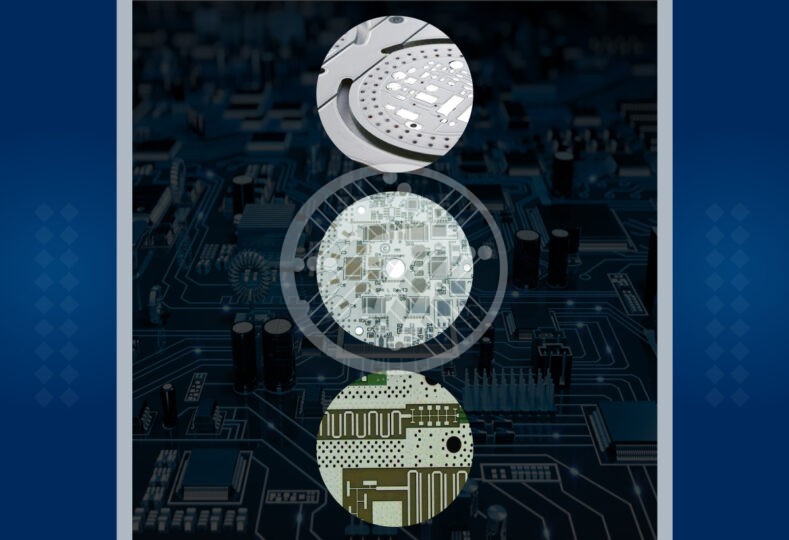Aluminum PCB Boards: A complete guide to understand its properties and applications!

Speak of aluminum PCB board and you are sure to speak of their electrical performance as also their thermal dissipation as well as their high dielectric strength. In use since the 1970s, they have in the recent years seen wide spread application.
These PCBs particularly come in extremely handy where high power and tight tolerances are required. The three major layers of an aluminum PCB board include:
- Circuit Layer – This essentially consists of a copper foil that could vary in weight from 1 to 10 ounce.
- Thermal Insulation Layer – This is made up of ceramic polymer. The layer is extremely important as it offers both thermal resistance as well as protects the board from mechanical stress.
- Base Layer – This is made up of aluminum alloy substrate & find wide use where through-hole technology is used.
Classification of Aluminum PCBs
Typically, Aluminum PCB board can be classified into 3 types basis the composition of the dielectric layer. These are:
- Universal Aluminum PCB – In such PCBs the dielectric layer is composed of epoxy glass fiber prepreg.
- High Thermal-Conductive Aluminum PCB – Here the dielectric layer is composed of epoxy resin.
- High-Frequency and Microwave Aluminum PCB – Here the dielectric layer is composed of either polyolefin resin or polyimide resin glass fiber prepreg.
Aluminum PCB boards can also be classified basis their application into:
Flexible Aluminum PCB
With miniaturization becoming increasingly prevalent, the need for flexible PCBs is only growing. Aluminum being naturally flexible, such PCBs are being increasingly used as they can fit smaller spaces.
Hybrid Aluminum PCB
Such PCBs use a combination of different materials for enhanced performance. For example, aluminum added to a FR-4 PCB result in improved heat dissipation abilities.
Through-Hole Aluminum PCB
Aluminum being a good conductor of electricity, it is important that the through-hole aluminum laminates be filled with a dielectric material so that the aluminum layer is isolated. Post filling of the dielectric material, aluminum is stacked & cured. The PCB is next electroplated with a conducting material.
Multi-Layer Aluminum PCB
In such PCBs multiple insulating layers are used. In fact, there can be more than one layer of aluminum as the core. The different layers are then connected through vias.
Properties of Aluminum PCB Board
- The most important property on account of which Aluminum PCBs find wide spread application is their ability to dissipate heat quickly.
- The advantage with Aluminum PCBs is also that there is minimal expansion & contraction of components on the board surface.
- They are also known for their dimensional stability. In fact, when heated upto 150 degrees Celsius they only show a 2.5%-3% change in dimensions.
- It is also known for its light-weight, strength, and mechanical endurance.
- Aluminum is known for its durability. With its use the risks of accidental breakage are greatly reduced.
- It is environment friendly as it is non-toxic as well as recyclable.
- With aluminum being easy to mine & refine, it is known to be economical.
Application of Aluminum PCB Board
The use of aluminum PCBs is becoming quite ubiquitous on account of their properties. Some of the areas where they find application include:
- Power transmission systems
- Power converters
- Different kinds of lighting
- Tail light assemblies
- Scanners
- Signal beacons
- Amplifiers & other audio equipment
- Computer Elements, and more.
To sum up
Aluminum PCB boards are widely in use on account of the fact that they withstand stress, have a high coefficient of thermal expansion, and more. Increasingly with the demand for high current handling, the use of aluminum PCBs is only growing. Coupled with edge plating & surface finishes aluminum PCBs are also known to work well in tough environmental conditions.
While there are various types of aluminum PCBs that come with their distinct advantages, it is important to go with a trusted electronics contract manufacturer whose expertise can improve the performance of PCBs. For example, an experienced manufacturer can make sure that if you need controlled impedance, modeling is undertaken. Similarly, tailoring signal reflections can go a long way in improving signal integrity. Manufacturer experience will also ensure that thorough Design Rule Checks are undertaken for designing such PCBs so that the manufacturing process is optimized.
If you have any questions or any requirements related to PCB manufacturing service, please feel free to contact us via email at [email protected] or call 714/630-9200.






